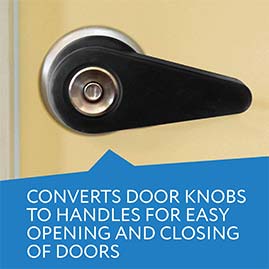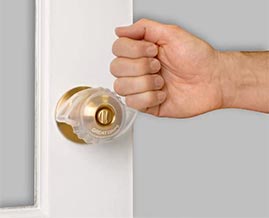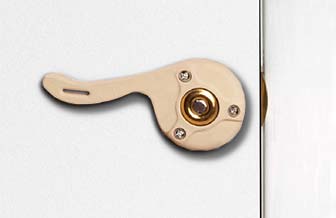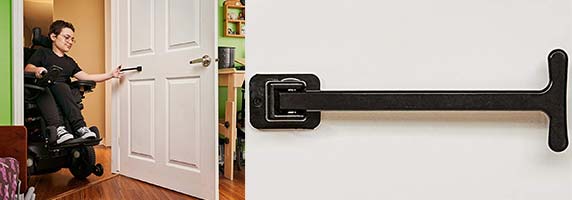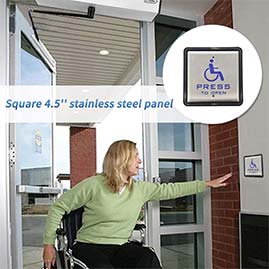Arthritis related joint pain and restrictions in the hands or fingers can make opening doors more difficult. By using assistive aids, door knobs can be modified to make opening and closing doors more easy.
The following adaptive arthritis equipment for door knobs can make the disabled or elderly more independent with entering and exiting through a doorway:
- Non-slip door knob cover grips – specialized grip that allows better grasping of door knobs for arthritic hands
This rubber cover slips over various styles of doorknobs to give them an extra surface to grab onto, which makes opening of doors easier. These covers can fit the following door knob styles:
- Ball
- Brandywine
- Cove
- Tylo
Whether suffering from arthritis or finger pain, the ergonomic ribs help those struggling with turning regular slippery door knobs and allow anyone to open doors more easily.
- Rubberized door handle extender – convert door knobs into handles with this extension for the elderly that have difficulty grasping a small knob
Installing a handle is one way to adapt door knobs to be more accessible. When a lever is added to a door knob, it helps provide more surface area to grasp and hold when opening the door.
This equipment is easy to install and slips over a door knob in seconds without any tools.
- Great Grips door knob wings – “wings” can be used as door handle grips for arthritis sufferers to open doors more easily with or without grasping the knob
A low cost alternative to replacing difficult to turn door knobs is to utilize a plastic cover to provide additional grip.
The wing tipped design can make opening doors easy, even when one’s hands are full or occupied with holding something. This feature is beneficial for advanced arthritis sufferers that may need to open doors with their elbows or arms.
Also, the wings can have a removable glow in the dark insert inside to help with finding the door knob in low lighting or at night.
- Door knob extender – open doors more easily by converting a door knob into a door handle with this extension device that installs overtop
By installing a handle extender to a door, it is possible to push down on the lever to open a door rather than needing to twist a knob. This can be helpful for people with hand arthritis that affects the fingers to the point where they experience pain or difficulty with grasping.
This equipment requires a screwdriver to secure it to a door knob, but can easily be installed in under 5 minutes.
Adaptive door closing and automatic opening equipment
Arthritis sufferers may benefit from other adaptive door equipment to assist with either closing a door or automatically opening one. These are some of the tools that can be used:
- Manual door closer – easily close doors by pulling a T handle installed onto a door near the hinge
This equipment is meant to act as an accessible door handle for individuals with mobility challenges. It can be installed either on the interior or exterior of a door, and provides a handle within reach to be pulled on to close a door.
The handle’s T shape gives it a large surface area to grasp, which can make closing doors easier for arthritic hands.
The handle’s close placement near the hinge means that the door can be easily closed, without having to step in to reach for the knob and quickly step through the doorway as the door swings closed.
- Automatic handicap door opener with remote – automatically open doors with the push of a wall mounted handicap button or by pressing the remote control
This is a helpful accessibility feature that can be installed on most doors to convert them into a handicap accessible entry way.
The door stays open for a certain length of time which can allow a wheelchair user, someone with slow gait or difficulty with mobility to safely traverse through the doorway without it swinging closed on them.
Should additional time be needed, the portable remote control can be pushed to activate the opening mechanism again.

